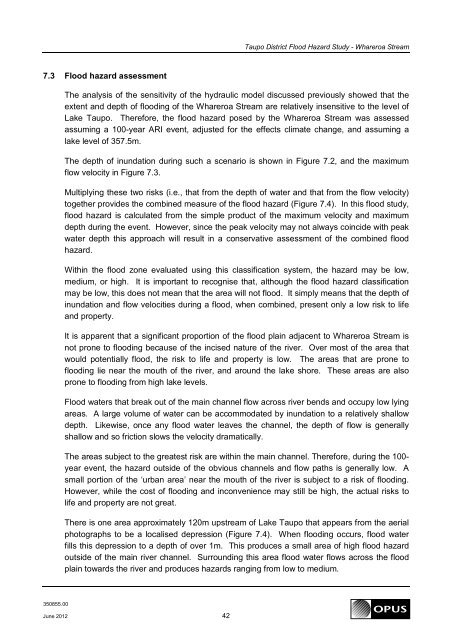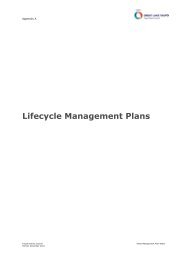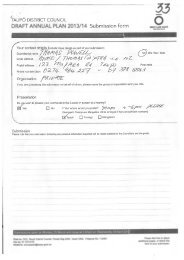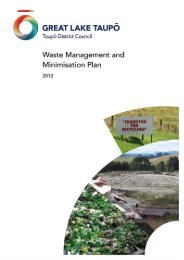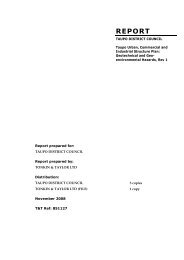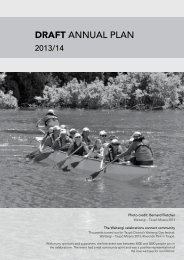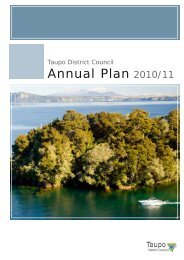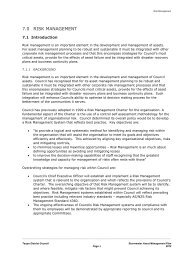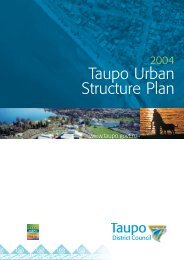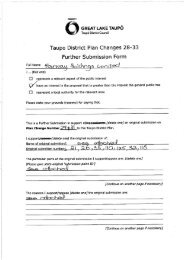Taupo District Flood Hazard Study - Whareroa Stream June 2012
Taupo District Flood Hazard Study - Whareroa Stream June 2012
Taupo District Flood Hazard Study - Whareroa Stream June 2012
Create successful ePaper yourself
Turn your PDF publications into a flip-book with our unique Google optimized e-Paper software.
<strong>Taupo</strong> <strong>District</strong> <strong>Flood</strong> <strong>Hazard</strong> <strong>Study</strong> - <strong>Whareroa</strong> <strong>Stream</strong><br />
7.3 <strong>Flood</strong> hazard assessment<br />
The analysis of the sensitivity of the hydraulic model discussed previously showed that the<br />
extent and depth of flooding of the <strong>Whareroa</strong> <strong>Stream</strong> are relatively insensitive to the level of<br />
Lake <strong>Taupo</strong>. Therefore, the flood hazard posed by the <strong>Whareroa</strong> <strong>Stream</strong> was assessed<br />
assuming a 100-year ARI event, adjusted for the effects climate change, and assuming a<br />
lake level of 357.5m.<br />
The depth of inundation during such a scenario is shown in Figure 7.2, and the maximum<br />
flow velocity in Figure 7.3.<br />
Multiplying these two risks (i.e., that from the depth of water and that from the flow velocity)<br />
together provides the combined measure of the flood hazard (Figure 7.4). In this flood study,<br />
flood hazard is calculated from the simple product of the maximum velocity and maximum<br />
depth during the event. However, since the peak velocity may not always coincide with peak<br />
water depth this approach will result in a conservative assessment of the combined flood<br />
hazard.<br />
Within the flood zone evaluated using this classification system, the hazard may be low,<br />
medium, or high. It is important to recognise that, although the flood hazard classification<br />
may be low, this does not mean that the area will not flood. It simply means that the depth of<br />
inundation and flow velocities during a flood, when combined, present only a low risk to life<br />
and property.<br />
It is apparent that a significant proportion of the flood plain adjacent to <strong>Whareroa</strong> <strong>Stream</strong> is<br />
not prone to flooding because of the incised nature of the river. Over most of the area that<br />
would potentially flood, the risk to life and property is low. The areas that are prone to<br />
flooding lie near the mouth of the river, and around the lake shore. These areas are also<br />
prone to flooding from high lake levels.<br />
<strong>Flood</strong> waters that break out of the main channel flow across river bends and occupy low lying<br />
areas. A large volume of water can be accommodated by inundation to a relatively shallow<br />
depth. Likewise, once any flood water leaves the channel, the depth of flow is generally<br />
shallow and so friction slows the velocity dramatically.<br />
The areas subject to the greatest risk are within the main channel. Therefore, during the 100-<br />
year event, the hazard outside of the obvious channels and flow paths is generally low. A<br />
small portion of the ‘urban area’ near the mouth of the river is subject to a risk of flooding.<br />
However, while the cost of flooding and inconvenience may still be high, the actual risks to<br />
life and property are not great.<br />
There is one area approximately 120m upstream of Lake <strong>Taupo</strong> that appears from the aerial<br />
photographs to be a localised depression (Figure 7.4). When flooding occurs, flood water<br />
fills this depression to a depth of over 1m. This produces a small area of high flood hazard<br />
outside of the main river channel. Surrounding this area flood water flows across the flood<br />
plain towards the river and produces hazards ranging from low to medium.<br />
350855.00<br />
<strong>June</strong> <strong>2012</strong> 42


